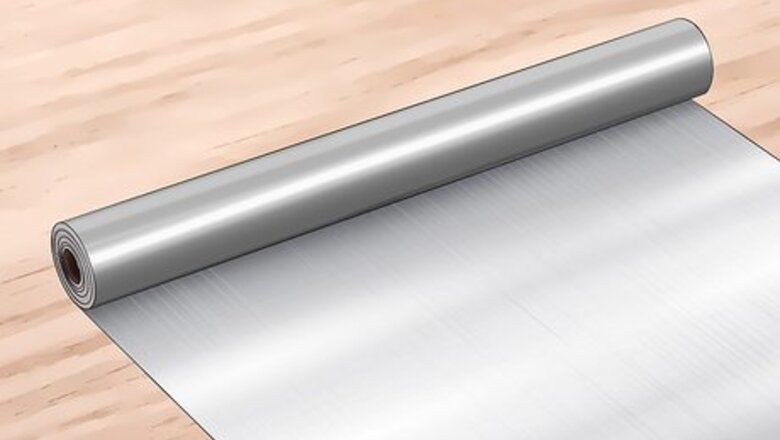
views
Prepping the Cabinet
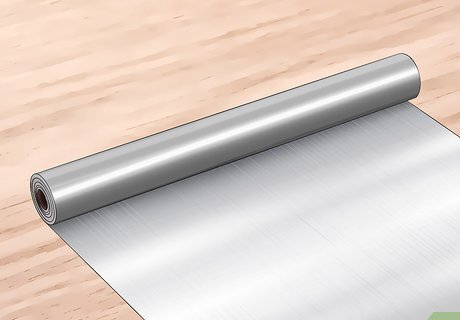
Get decorative stainless-steel contact paper. Stainless steel contact paper is designed for use on metal, so it’s your best choice for decorating a file cabinet. Contact paper comes in many designs and colors, so examine the room you'll be placing the file cabinet in. Consider what colors or styles match the area, and which textures would complement the other furniture. You can buy contact paper from craft stores or online. It comes in rolls, so one roll should be enough for this job. For a more decorative approach, try using a different contact paper on the drawers and sides of the cabinet. This creates a nice blend, if the styles match. Consider using the same contact paper on other pieces throughout the room, like your desk. This will create a nice, matching environment.

Pull the cabinet out so you have plenty of room to work. If the cabinet is tucked next to a desk or somewhere else that’s inaccessible, pull it out so you can get to both sides and the back without any trouble. You’ll need a few feet of room on all sides of the cabinet. If the cabinet is heavy, empty the drawers before you move it. Get someone to help you if you need it. This isn’t a messy job, so don’t worry about putting out a drop cloth or something to contain a mess. However, you might want to take the opportunity to clean behind the cabinet.
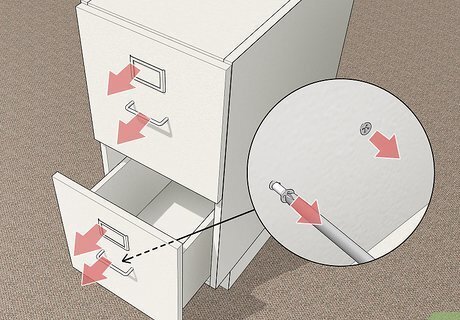
Remove the hardware from the front of the drawers. Start by removing the screws holding the back plate on the front of the drawer. Remove the plate to expose the screws holding the handle and latch on. Unscrew these. Finally, lift and pull on the tag plate to remove it. Put the hardware in a safe place so you don’t lose it while you’re working. It’s also possible to put the contact paper on with the hardware still attached, but you’ll have to spend more time cutting holes for it as you go. This is tie-consuming, but saves you the trouble of removing and replacing the hardware.

Wipe down the cabinet with rubbing alcohol. Pour some alcohol onto a rag or paper towel. Clean off the whole exterior of the cabinet and re-wet the rag as you have to. This removes any dust or debris that will stop the paper from sticking properly. You could also use mineral spirits or vinegar to wipe down the cabinet. Both are good solvents.
Applying the Paper
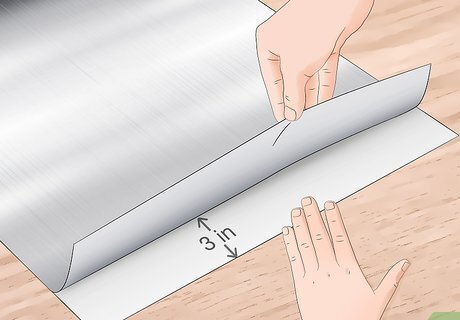
Peel off about 3 in (7.6 cm) of the contact paper backing. Start on any side of the cabinet. Peel off 3 in (7.6 cm) of the contact paper backing. Hold it from the corners so it doesn’t get stuck on your hands. Do not peel off a whole sheet of contact paper at once. This will be much too unwieldy and the paper could get stuck to itself. Working in small increments makes this job much easier.
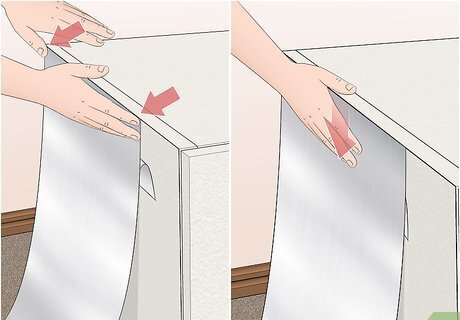
Press the edge of the paper along the top of the cabinet. Hold the edge of the paper up to the very top of the cabinet. When the 2 edges are even, press the paper down. Run your finger along the edge of the paper so it attaches evenly. Then press the remaining 3 in (7.6 cm) down with firm pressure. It’s okay to overlap the edge of the cabinet a little bit. You can cut or fold the excess paper down later. It’s more important to make sure you don’t come up short.

Rub the paper with a squeegee to remove any air bubbles. Work in even rows from one side of the paper to the other. Smooth the paper down from top to bottom and work out any air bubbles. Work the bubbles towards the sides or bottoms of the paper. Don’t press on them directly or the paper could rip. You could also use any flat, firm object to smooth out the paper. A wooden ruler or credit card, for example, would work as well.
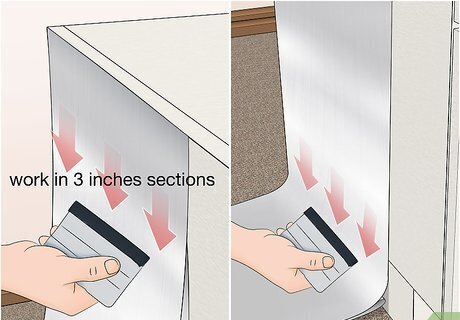
Work in 3 in (7.6 cm) sections until you reach the bottom of the cabinet. Continue the same motion you started with. Peel off a few inches of backing paper, press the contact paper down, and work out any air bubbles with a squeegee. Keep working downward until you reach the bottom of the cabinet. If you do mess up at any point, just carefully peel the paper back up and reapply it. It comes off easily and will still stick well even if you remove it once or twice.
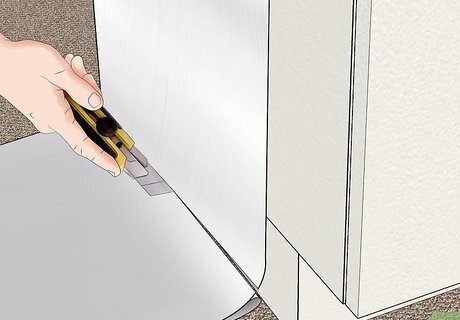
Cut the paper evenly with the bottom of the cabinet. Once you complete a column, take a utility knife or sharp pair of scissors. Work along the bottom of the cabinet so the paper is even with the edge. Don’t worry if the paper isn’t perfectly even with the edge of the cabinet. You can touch it up later on by cutting more off. If the cabinet is next to something, the bottom may not even be visible. Be careful when using a knife. Pay attention and keep your fingers away from the blade.
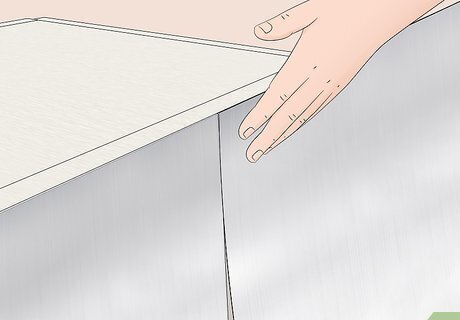
Apply another column next to the first one if the cabinet is still exposed. If one column of contact paper didn’t cover the whole side, the repeat the same procedure with another column. Line up the contact paper with the top of the cabinet and the seam of the first column, press it down in small sections, and cut it off at the bottom. If the contact paper has a particular design on it, make sure to line up the patterns. Otherwise, the design will be uneven.
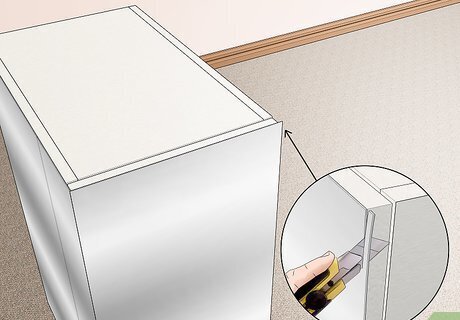
Cut off any remaining excess paper on the edges of the cabinet. If the contact paper overlaps the sides of the cabinet, simply cut it off. Work along the edge of the cabinet so the paper and corner are even with each other. You could also fold the paper around the edge. This could provide more comprehensive coverage.
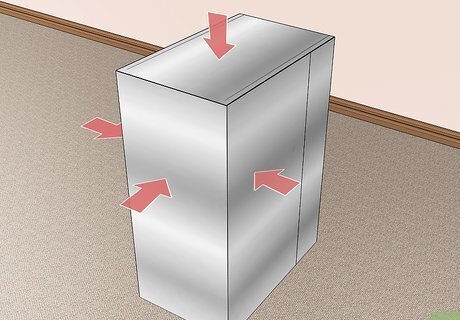
Repeat the process to cover all sides of the cabinet. Use the same procedure to cover the sides, front, top, and back of the cabinet. Peel off a bit of paper, press it down, smooth it out, then work down until you hit the bottom. This includes the front as well, so cover the drawers with contact paper. If you have trouble covering the top of the cabinet, stand on a step stool or tip the cabinet onto its side. If you’re using different types of contact paper, remember to put the different designs in the appropriate places.
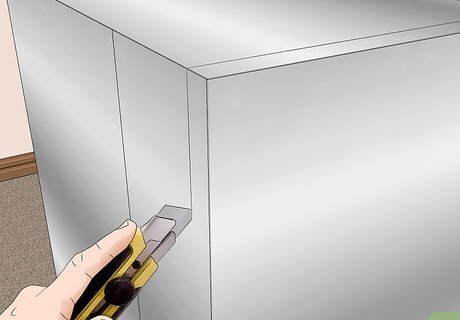
Cut around all the drawers and hardware. Take your knife or scissors and work around the border of each drawer. This lets you open them. Then feel along the front of each drawer for the hardware holes. Cut small holes here so you can reattach the handles and other hardware. If you left the hardware attached, then cut holes as you press the paper down so the hardware fits through..
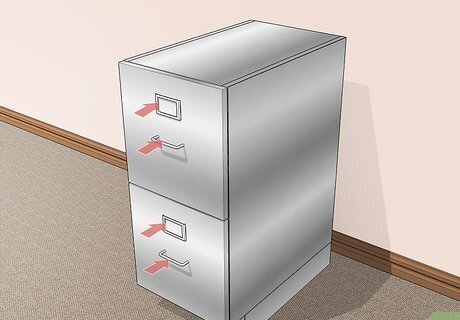
Replace the hardware on the drawers. First, put the tag holder bag into place by tucking it into its spot. Then, screw the handles and latch back on. Replace the back plate of the drawer and the job is complete.











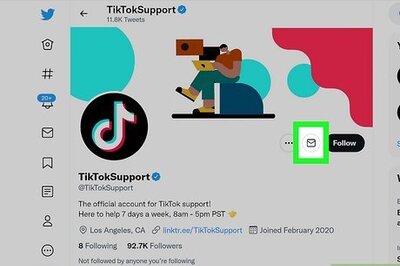





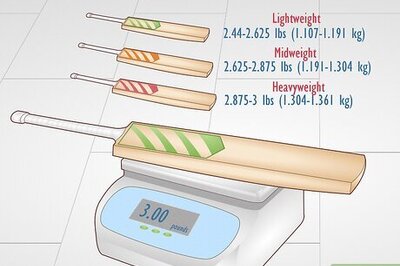
Comments
0 comment